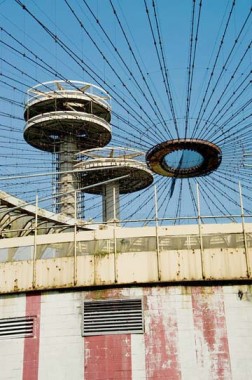Now, let’s not get too beside ourselves yet. The vote the New York State Board of Preservation took to add Philip Johnson’s New York State Pavilion, which has been sitting and rusting since the Fair closed in October 1965 to add it to the state Register of Historic Places does not mean it won’t be torn down in the future. But it does mean that there will be a lot of egg on a lot of faces if it does eventually get razed. Only a designation by the New York Landmarks Preservation Commission has enough teeth to ensure survival. The designation does open up the possibility of rehabilitation, which would, after 44 years of basically nothing, would be a daunting proposition.
From the ForgottenBook:
Designed by Philip Johnson, the NY State Pavilion was among the most striking buildings at the Fair when it opened. It consists of the “Tent of Tomorrow” made up of16 100-foot columns supporting a 50,000 sq. foot roof of multicolored panels (which was removed in the 1970s) as well as three towers, measuring 60, 150 and 226 feet tall. Fairgoers could ascend top the top of the towers via “Sky Streak” capsule elevators. Inside the pavilion, there was a scale model of the new St. Lawrence River hydroelectric plant, NY State industry information, artwork from the 19th-century Hudson River School, and portraits of NY State colonists.
The NY State Pavilion contained striking visuals both above and below. Texaco funded a giant map of New York State on the pavilion floor with 567 mosaic terrazo panels weighing about 400 lbs. each. Rand McNally supplied the topographic information, and Texaco furnished the location of each of its gas stations in the state. When the pavilion’s roof was removed due to its deterioration borne of general negligence, the Texaco map was open to the elements. It’s still there, but padlocked and severely decayed. The “Sky Streak” elevators are still there, awaiting reactivation if that ever happens. [They were finally removed in 2007]
A study is ongoing that would determine if the Pavilion is structurally sound, after all these years, to even be a candidate for rehabilitation. The new status makes it eligible for grants to that effect, should rehab be a possibility. The University of Pennsylvania will also weigh in. Students from the U. had earlier “rescued” some of the chipped and broken tiles from the Texaco map.
It’s very good news — just recently I was saying that if the City or State is unwilling to repair the structure, it should be pulled down before it gets even more hazardous. Perhaps now, it can be repaired as a symbol of Flushing Meadows and join the Unisphere as a symbol of Queens.
Photographed August 16, 2009; page completed September 16, 2009. Special assistance by Steve Garza and Christina Wilkinson






1 comment
I remember going there when I was 11 or 12 years old in the early 1970s. At this time, it was being operated as a roller skating rink. I vividly remember the very large map of New York State on the floor of the rink (although I don’t remember the Texaco gas stations). I would love to see this site get a complete renovation.